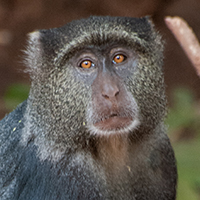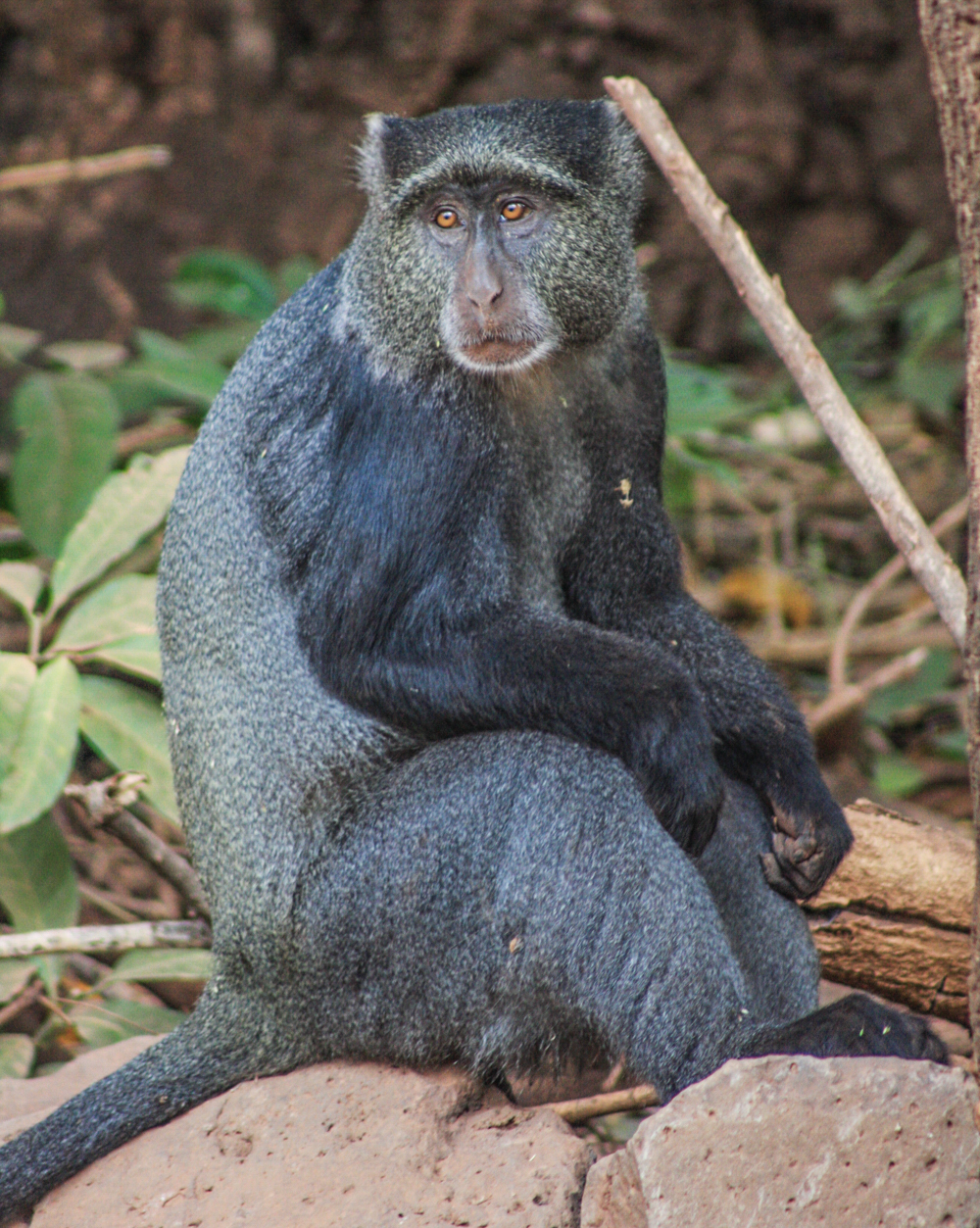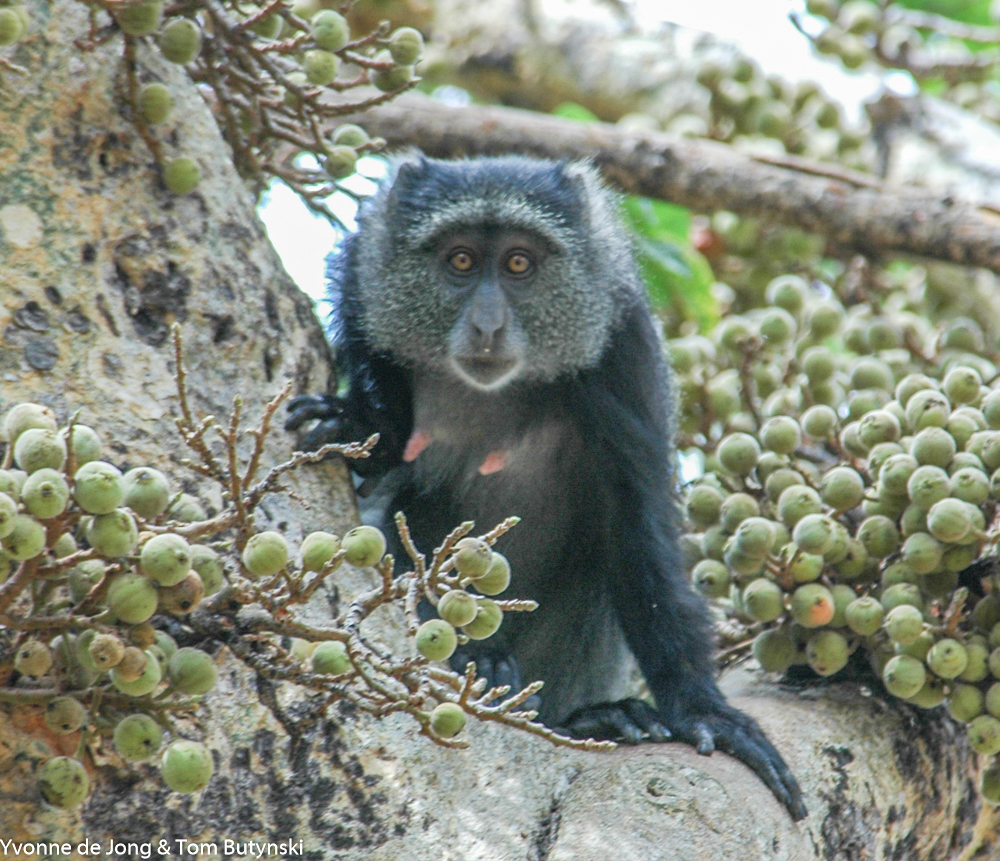
The Manyara Monkey: A New Subspecies of Monkey Endemic to Tanzania
Thomas Butynski and Yvonne de Jong,
Eastern Africa Primate Diversity and Conservation Program
The taxonomy of the Gentle Monkey Cercopithecus mitis has been debated for many decades, mainly due to the complex and wide distribution of its many subspecies. Tanzania and Kenya, together, support no fewer than eight of the currently recognized 17 subspecies. In the most recent issue of Primate Conservation (Issue 34, April 2020), Butynski and De Jong review the taxonomy and distribution of these eight subspecies and describe a new subspecies endemic to central north Tanzania, the Manyara Monkey Cercopithecus mitis manyaraensis. This new subspecies is named after Lake Manyara which lies near the centre of its geographic range.

Adult male Manyara Monkey Cercopithecus mitis manyaraensis (Paratopotype 2) at Lake Manyara National Park, central north Tanzania. Photograph by Yvonne de Jong & Tom Butynski.
The Manyara Monkey occurs from the Ngorongoro Conservation Area in the northwest, southwards through Lake Manyara National Park (including Marang Forest) to the Nou Catchment Forest Reserve and Ufiome Forest Reserve. The geographic range is at least 1,500 km² but may be as large as 5,900 km². The Manyara Monkey occupies various types of forest from 960 m above sea level to at least 2,550 m asl, but likely reaches the highest forest of the Ngorongoro Conservation Area at 3,260 m asl.
Cercopithecus mitis is well-known for the Lake Manyara-Ngorongoro Region, a region much visited by tourists. Until now, however, this population was referred to as a “hybrid swarm” comprised of Stuhlmann’s Blue Monkey C. m. stuhlmanni, Zanzibar Sykes’s Monkey C. m. albogularis, and their descendents. The authors, however, found no evidence for a hybrid swarm. The Manyara Monkey is geographically isolated, phenotypically distinct, and presents little intra-population variation.
Butynski and De Jong put forth two hypotheses for the origin of the Manyara Monkey. Hypothesis I: It represents a now isolated section of a phenotypic cline that once extended across the Eastern Rift Valley. Hypothesis II: It is a close relative of the Mweru Monkey C. m. opisthostictus and, thereby, is a relic of dispersal from the Congo Basin/Upper Zambezi Basin to the Lake Manyara-Ngorongoro Region. To unravel the complex evolutionary history of C. mitis, and to stabilize it taxonomy, molecular research and additional biogeographic research are required.
The future of the Manyara Monkey is uncertain due to threats associated with the region’s rapidly increasing human population (e.g., expanding agriculture, settlements, roads, mining, collection of fuelwood, unsustainable grazing and browsing by livestock). De Jong and Butynski, who assessed the Manyara Monkey for the IUCN Red List of Threatened Species 2020, concluded that this taxon is ‘Endangered’ despite the fact that about 60% (c. 3,500 km²) of the probable geographic distribution lies within six protected areas. Conservation priorities for the Manyara Monkey are (1) improve management of the six protected areas in which it occurs, and (2) restore and protect the wildlife corridors of the Lake Manyara-Ngorongoro Region.

Adult female Manyara Monkey Cercopithecus mitis manyaraensis at Mto wa Mbu, central north Tanzania. Photograph by Yvonne de Jong & Tom Butynski.
Tanzania is one of the most important countries in Africa for primate conservation given its 44 primate taxa, 13 endemic primate taxa, and 21 globally threatened primate taxa. Tanzania is, however, losing about 200 km2 of forest each year (at 1.1%, the second highest annual rate of forest loss in sub-Saharan Africa) and has a 3% human population ‘Rate of Natural Increase’ (compared to 1% worldwide). It is, therefore, inevitable that Tanzania will continue to lose large areas of forest and large numbers of forest-dependent primates.
The full article can be accessed here. Additional images of the Manyara Monkey can be viewed on our ‘Gentle Monkey Photographic Map’: http://www.wildsolutions.nl/photomaps/mitis/
Butynski, T.M. and De Jong, Y.A. 2020. Taxonomy and biogeography of the gentle monkey Cercopithecus mitis Wolf, 1822 (Primates: Cercopithecidae) in Kenya andTanzania, and designation of a new subspecies endemic to Tanzania. Primate Conservation 34.


Colin Congdon
| #
Having lived in Tanzania for 60 years I have witnessed at first hand the catastrophic population explosion which has already resulted in much loss of habitat. I fear your predictions are fully justified. But well done for producing a good paper.
Reply
Elvira Wolfer
| #
thank you for this interesting article and all the efforts you took for this research.
Yes, sadly the uncontrolled human number increament is devastating for nature and its inhabitants.
Kind regards
Reply
Mito-phylogeny of Cercopithecus mitis manyaraensis - Wildsolutions
| #
[…] Download the full article More information about the Manyara Monkey […]
Reply